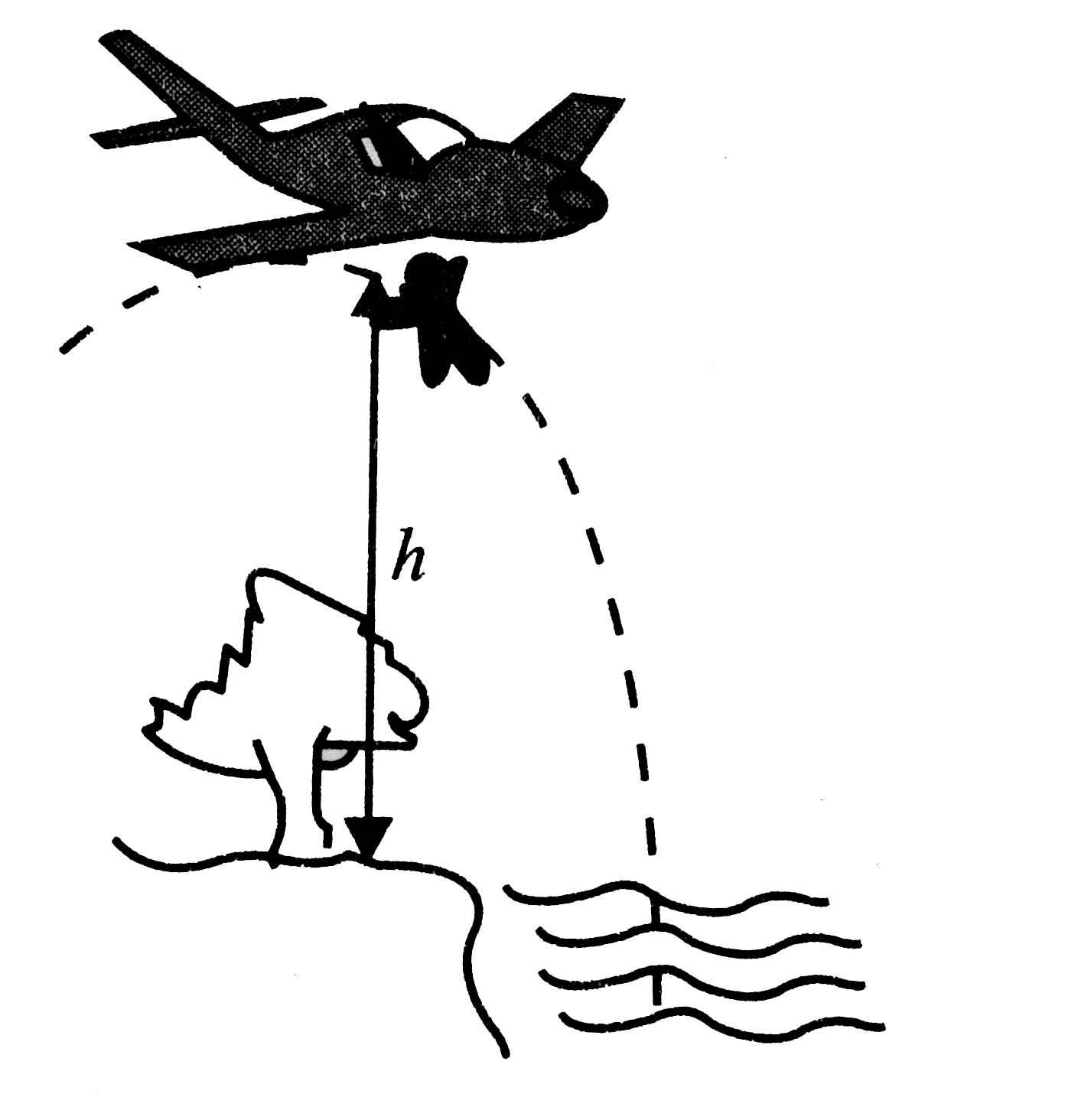A person of mass 60 kg jumps from a height of 5 m, onto the ground. If he does not bend his knees on touching the ground, he comes to rest in 110 s. But if he bends his knees, he takes 1 s to come to rest. Find the force exerted by the ground on him in the two cases. [ g = 10 m ⋅s2 ] Solution in Bengali
Let v = velocity acquired during the free fall through 5 m.
∴ v2=0+2×10×5 or,v=10 m⋅s−1
This velocity becomes zero due to the impact with the ground. Then, change in momentum
= mv−mv=60×10−0=600Ns
Force applied by the earth for this change,
in 1st case, F1=600110=6000N
in 2nd case, F2=6001=600N
Hence, the impact in the 1st case is more severe than in the 2nd case, where the momentum changed at a shower rate.
Topper's Solved these Questions
- BOOK - CHHAYA PUBLICATIONCHAPTER - NEWTON'S LAWS OF MOTIONEXERCISE - SECTION RELATED QUESTION10videos
NEWTON'S LAWS OF MOTION
- BOOK - CHHAYA PUBLICATIONCHAPTER - NEWTON'S LAWS OF MOTIONEXERCISE - HIGHER ORDER THINKING SKILL (HOYS) QUESTIONS26videos
NEWTON'S LAWS OF MOTION
- BOOK - CHHAYA PUBLICATIONCHAPTER - NATURE OF VIBRATIONEXERCISE - EXERCISE (CBSE SCANNER)2videos
NATURE OF VIBRATION
- BOOK - CHHAYA PUBLICATIONCHAPTER - NEWTONIAN GRAVITATION AND PLANETARY MOTIONEXERCISE - CBSE SCANNER19videos
NEWTONIAN GRAVITATION AND PLANETARY MOTION
Similar Questions
State Newton's second law of motion.
02:32View SolutionA metal ball is suspended from the roof of a train by a string. When the train is in uniform motion, will the string remain vertical? What happens to the string if the train accelerates?
04:06View Solution(i) What do you mean by resonance ? (ii) Mention any two uses of its from your daily life.
02:51View SolutionWhat is the reason for absence of atmosphere in some planets?
01:44View SolutionA man of mass M=58kg jumps from an airplane as shown in Fig. He sees the hard ground below him and a lake at a distance d=1m from the point directly below him. He immediately puts off his jacket (mass m=2 kg) and throws it in a direction directly away from the lake. If he just fails to strike the ground, find the distance (in 101m) he should walk now to pick his jacket. (Neglect air resistance and take the velocity of man at the time of jump with respect to earth zero.)
 06:10View Solution
06:10View SolutionA man whose mass is m kg jumps vertically into air from the sitting position in which his centre of mass is at a height h1 from the ground. When his feet are just about to leave the ground his centre of mass is at height h2 from the ground and finally centre of mass rises to h3 above the ground when he is at the top of the jump. what is the average upward force exerted by the ground on him?
05:05View SolutionHow much pressure will man of weight 60 kg exert on the ground when (a) he is standing on his feet and (b) he is lying on ground. Given that the area of a foot is 100cm^(2) and areaa of the body of a man in contact with ground = 0.6 m^(2) . Use g=10m//s^(2)
03:26View SolutionHow much pressure will a boy of wieght 50 kg f exert on the ground when (i) he is lying on ground and (ii) he is standing on his feet ? It is given that the area of the body of the boy is 0.5m2 and that of foot is 60cm2. Use g=10m/s2.
04:20View SolutionA parachutist drops freely from an aeroplane for 10 seconds before the parachute opens out. Then he descends with a net retardation of 2m/s2. His velocity when he reaches the ground is 8m/s find the height at which he gets out of the aeroplane?
03:28View SolutionA parachutist after bailing out falls for 10 s without friction. When the parachute opens he descends with an acceleration of 2 m//s^(2) against his direction and reached the ground with 4 m//s from what height he has dropped himself? (g=10 m//s^(2))
06:37View SolutionA man is moving with 10m/s towards west on a horizontal ground. He observed that the rainfall is falling vertically down wards. Now he increases his speed to 15m/s and find that now the rainfall at an angle of 45∘ towards him. The speed of the rain with respect to ground is :
View SolutionIn order to make a jump straight up, a 60kg player starts the motion crouched down at rest. He pushes hard against the ground, raising his centre of mass by a height h0=0.5m. Assume that his legs exert a constant force F0 during this motion. At this point, where his centre of mass has gone up by h0 his feet leave the ground and he has an upward velocity of v. Centre of mass of his body rises further by h=0.8m before falling down [Take g=10m/s2]
(a) Find v.
(b) Find the normal force applied by the ground on his feet just before he left the ground.View SolutionFind the energy possessed by a bird of 5 kg moving at a constant height of 10 m from the ground with a speed of 2 m s^(-1) . (Take g = 10 m s^(-2) )
02:16View Solutionएक गुब्बारा 5.0 m/s के एकमान वेग से ऊपर की ओर जा रहा है | जब वह जमीन से 50 m ऊपर है, गुब्बारे में बैठा व्यक्ति एक पत्थर फेंक दिया, पत्थर जमीन पर पँहुचता है, उस समय जमीन से गुब्बारे की ऊँचाई निकाले | g=10m/s2 लें |
02:17View SolutionAn 80 kg stuntman jumps out of a window that's 45m above the ground Q. He lands on a large, air-filled target, coming to rest in 1.5 s. what average force does he feel while coming to rest?
04:48View Solution

